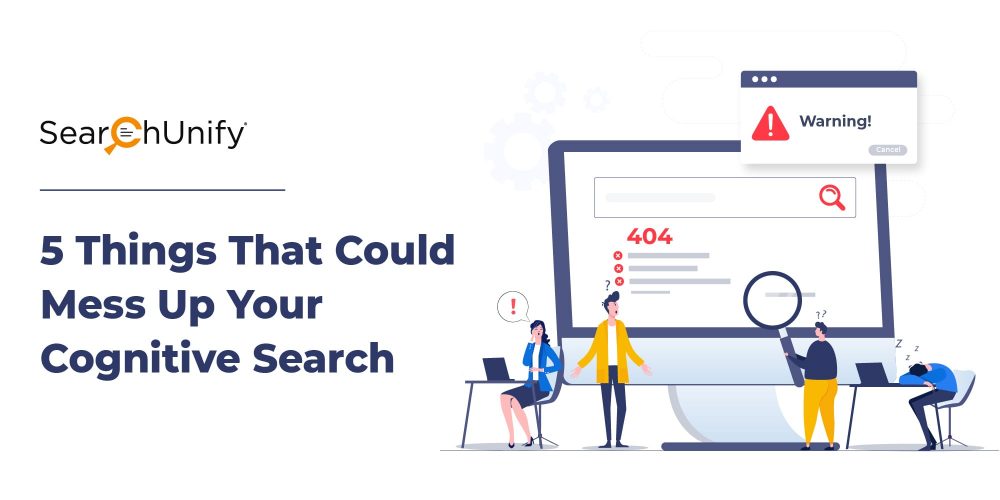

If I asked you to find a particular book in a chaotic library, which is neither organized nor labeled, would you be able to find it? Well, of course, if it were a matter of life or death, you would make a miserable & hasty attempt. But what if there was a time constraint and you had to unearth the book in a matter of seconds? Failure would be inevitable.
Chances are something of the kind has happened already with your employees. I am sure they can recount the horrors of the situation when a customer came up with a query and they had to search for an article or a document, across your gigantic (that’s what it must’ve felt at the time) enterprise. So, enterprise search holds an important place in every organization.
Firms have realized this and that is why the adoption of unified search has risen from a mere 7% to 19% from 2018-19 (Source). But even after implementing sophisticated search technology, there are a couple of things that can go wrong and derail your efforts. Here are 5 common blunders that can seriously mess up your search experience:
1. Not Knowing Your Audience
You may think that giving everyone access to everything is the last piece of the search puzzle. But this can be catastrophic for the business. The first thing you need to figure out is who you’re implementing search for and what their use case is. Customer support teams, community teams, product teams, etc. are all looking for information and they have their own set of problems that search can solve. So, the first step in your strategy should be identifying teams that require the enhanced search engine along with the repositories they frequent.
2. Not Cleaning the Obsolete Information
Search is only as good as relevant it is. The biggest roadblock to a successful search experience is outdated content that is no longer used by customers. For instance, there might be a product feature that is obsolete but the document related to it is still part of your knowledge base or community portal.
This type of content is of no use for customers, but it might be showing up on a higher rank than the new articles in some search results. The reason being that it would have a higher clickthrough rate thanks to its age. By doing so, it’s killing your customers’ search experience and making them go ballistic. Therefore, you need to keep archiving your obsolete content at regular intervals to help your enterprise search engine display the most helpful results.
3. Not Paying Attention to Search Tuning
Another common mistake we’ve seen organizations make is leaving the engine as it is. Delivering a flawless search experience requires periodic tinkering/adjustment of search settings. The article posted on your portal that is new and hot right now may not be that relevant after 3 months so it’s relevancy score needs to be adjusted. There might be a new bug that’s causing problems and people are searching for help articles related to it, hence content related to that needs to appear on top.
This is where tuning comes into play. It empowers you to promote or demote content as you seem fit. Boosting the ranking of content items ensures that users get the right results quicker. The latest search solutions offer different ways of boosting search results like – manual, automatic, etc.
4. Not Thinking Outside the (Search) Box
Search has gone way beyond simply the search box. It can actually be used to enhance different apps & interfaces. For instance, search-assisted chatbots can tap into search insights and deliver personalized interactions.
Search can aid in building dynamic recommendation lists based on the usage pattern of the respective user. This takes personalization up a notch and will increase user engagement at your portals since users generally do not interact with static menus on digital properties. AI-fueled search can enable real-time assistance inside the product in the form of contextual recommendations. This helps save users’ time who’d otherwise have to bounce around the help center, support community, etc. and then back to the product.
5. Not Using Human Intelligence With Artificial Intelligence
According to Gartner, by 2023, 40% of I&O teams will use AI-augmented automation in large enterprises, resulting in higher IT productivity with greater agility and scalability (Source). Having said that, you don’t want to put the plane in autopilot mode and let AI do the rest. AI works best when trained continuously with some human supervision.
AI takes a while to understand your users and content. Once that has been taken care of, the experience it provides will be nothing short of pleasing. The more your AI-fueled features learn, the more relevant they become. Keep track of how these features are behaving and make changes accordingly.
Want to make your search work impeccably? Here’s your complete guide!
Enterprise search has the power to transform your business but only if you have a well-thought-out strategy & the right search solution in place. To make the most of the cognitive engine, there are some lesser-known practices or secrets must be kept in mind before and after the implementation. Here’s an ebook that will cover it all and help you in your search journey.